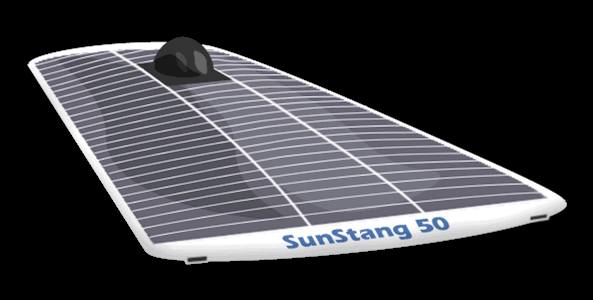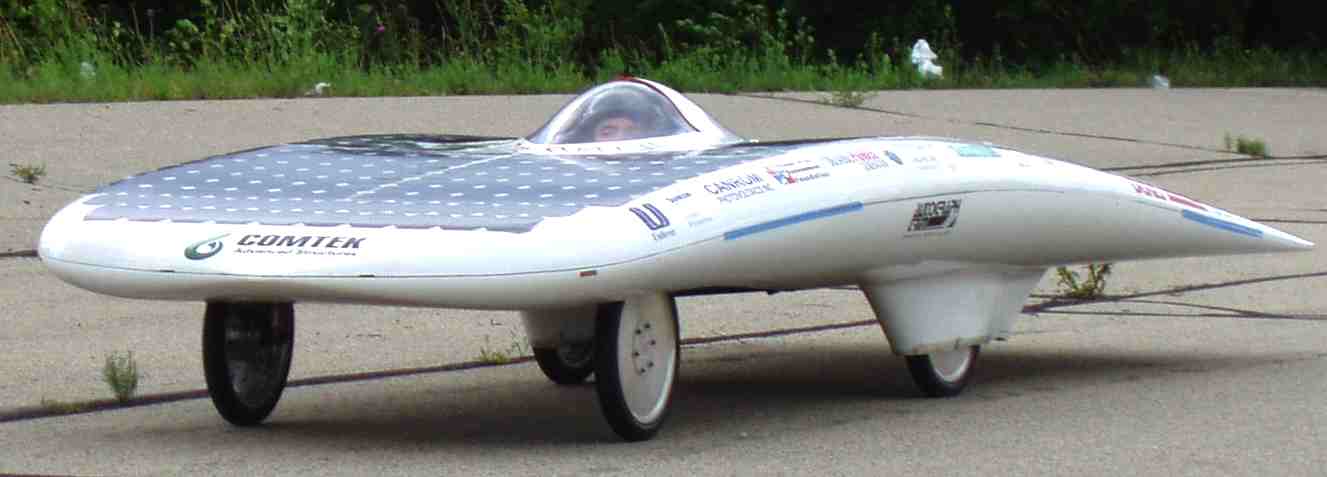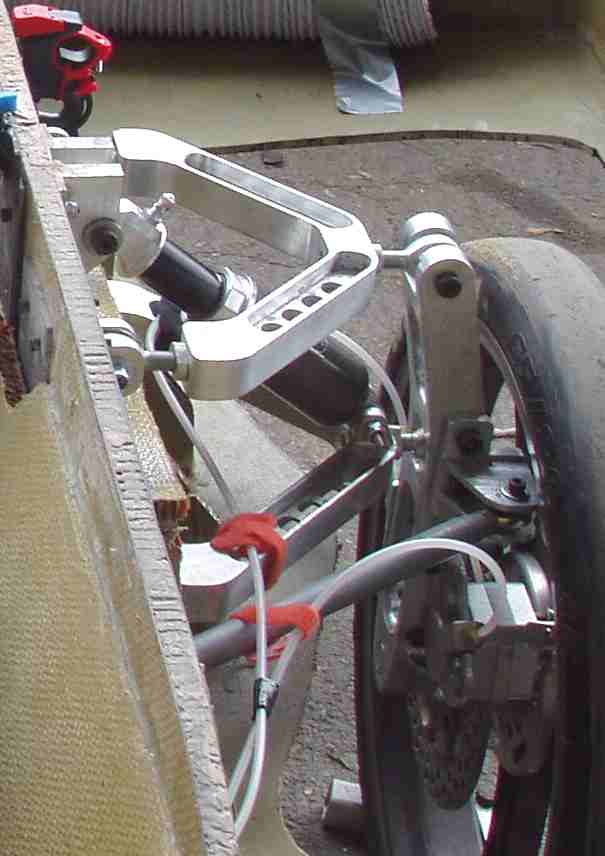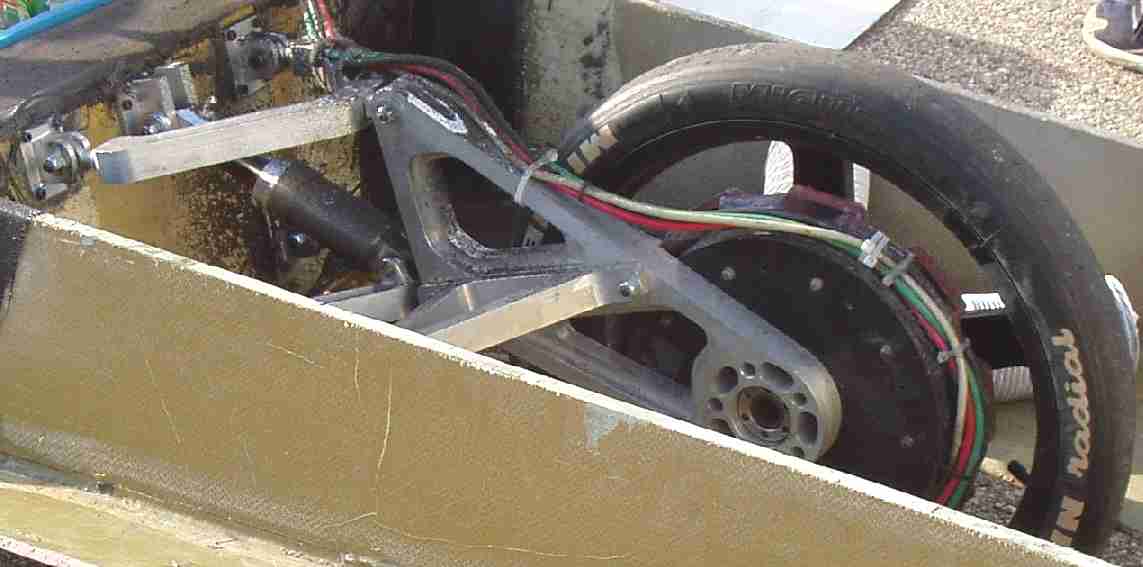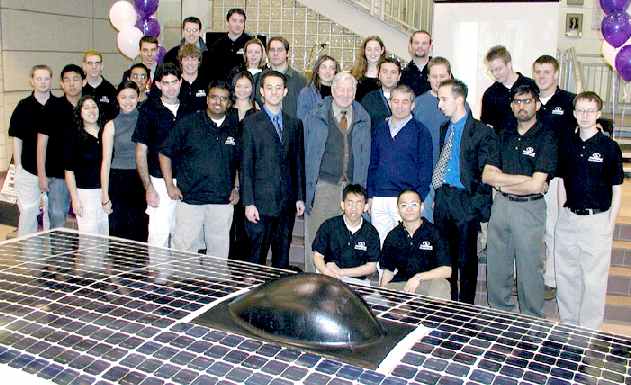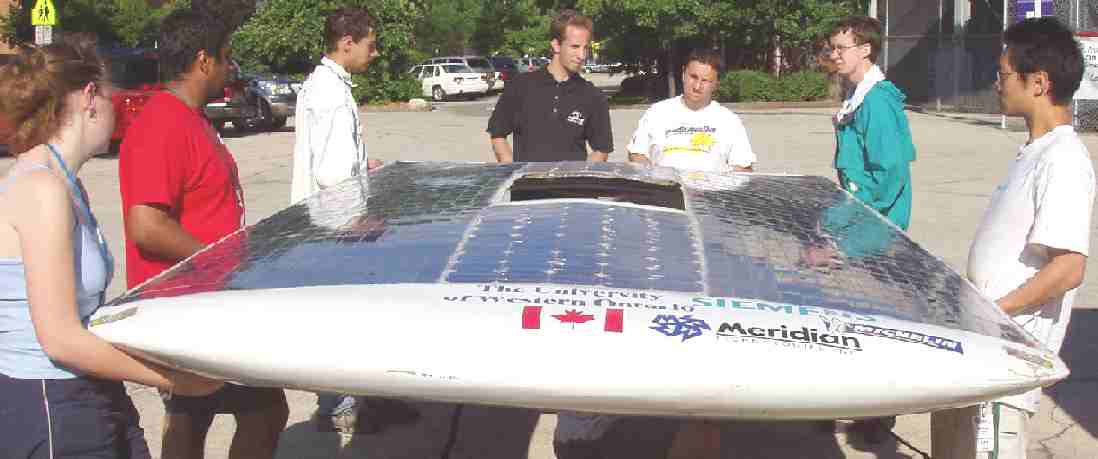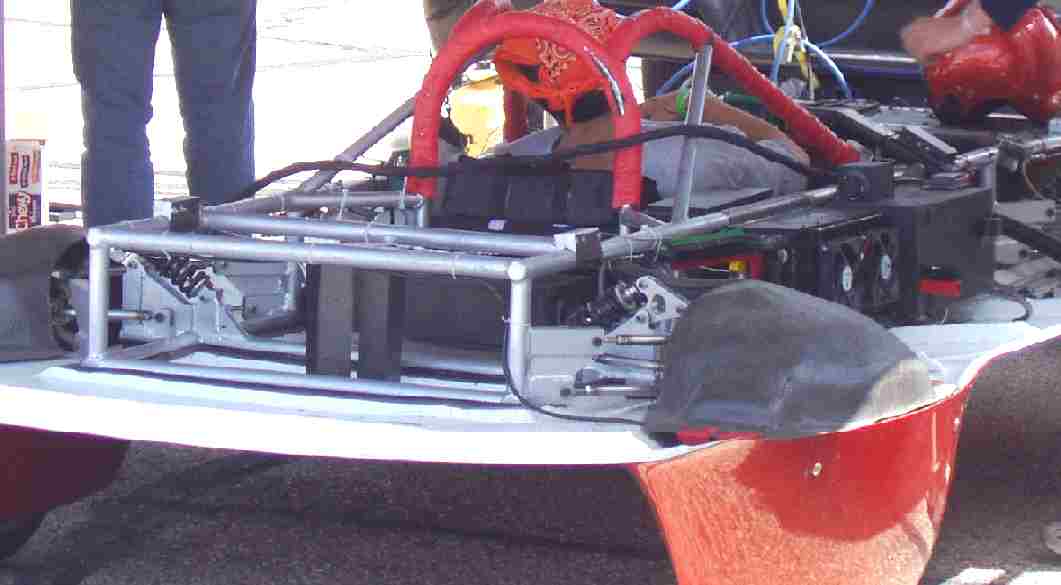|
||||||||||||||||||||||||||||||||||||||||||||||||||||||||||||||||||||||||||||||||||||||||||||||||||||||||||||||||||||||||||||||||||||||||||||||||||||||||||||||||||||||||||||||||||||||||||||||||||||||||||||||||||||||||||||||||||||||||||||||||||||||||||||||||||||||||||||||||||||||||||||||||||||
|
Over 40 students, faculty, and alumni work together with the generous support of countless sponsors to produce the Sunstang solar car. This combination between education and industry helps build a strong relationship within the community and provides the team with the necessary expertise to run a successful project.
Team History
The SunStang project was conceived as an honors research project for engineering students in the summer of 1991. Over the next two and a half years students from across UWO's campus contributed their time and resources toward the research, design, construction and testing of a solar vehicle. The result was SunStang '93 named after the University's mascot, the Mustang.
The SunStang's first true test was the 1993 World Solar Challenge. This grueling cross-continental 3000 km race from the northern tip of Australia to the southern most tip attracted some of the most advanced solar vehicles in the world. Participants included universities and major automobile manufacturers such as Honda R&D, Aisen Seki (Toyota), and Mitsubishi.
Due to adverse weather conditions and technical problems the team was forced to retire from the race. This however was not seen as a defeat but rather a challenge to improve what had been done before.
A new team was assembled in the summer of 1994 with the task of redesigning a new car for Sunrayce '95, a 1700 km race from Indianapolis Indiana, to Denver Colorado. During that time students from the faculties of Engineering Science, Science, Social Science, Arts and Nursing invested more than 25,000 volunteer hours to produce SunStang '95, which finished Sunrayce '95 in 21st position overall. SunStang '96 was also given the special honor of being the 2nd place rookie finisher.
Following the Summer of 1995, the dedicated team spent seven months redesigning and manufacturing a new car in time for the first Canadian Solar Discovery Challenge, a race from London, Ontario to Montreal, Quebec. The teams determination, perseverance, and commitment lead them to a well deserved victory in 1996.
The Canadian race fueled the team with confidence as time drew near for the World Solar Challenge in 1996, a grueling 3,000 km Australian outback odyssey. The team, made up of a determined group of students, had set a goal of finishing the race within the ten day limit. Not only did the new and improved SunStang '96 finish the race but placed 12th overall in the world and 2nd in North America - a significant achievement, widely acknowledged as a great success.
In 1997 the SunStang team took the car to Sunrayce '97 from Indianapolis to Colorado Springs. SunStang placed 13th overall and was presented with the Spirit Award. At this point the team began design on what was to become SunStang 2003. It was to be much more aerodynamic than the previous SunStangs.
Between the years of 1998-2000, the SunStang team experienced some down-time. In 2001 the SunStang team was revived and resumed work on SunStang 2003. In May of 2003 the team purchased a new set of high-density lithium ion polymer batteries from Electrovaya. The team then took the car to Chicago for the American Solar Challenge Qualifier. Unfortunately the car suffered a mechanical failure where the rear kingpin is fixed to the body panels.
In 2003, the team attended the American Solar Challenge Kickoff in Rolla Missouri where they learned valuable information about the mechanical and electrical systems of solar cars and developed ideas for future vehicles. The team built an aluminum chassis to reinforce the composite panels of SunStang 2003, improved the vehicle vision with a clear canopy and improved electrical components including regeneration, driver control and telemetry of the vehicle from 2003 to 2004.
In the June of 2004, the team traveled to Topeka Kansas for Formula Sun Grand Prix 2004. In spite of Kansas winds and rainstorms, the team persevered and placed 3rd in stock class, gaining valuable race experience. The team was granted the "Stuck To It" award.
VEHICLE SPECIFICATIONS
Aero body
SunStang 2005 represents a significant improvement over our past cars. Sunstang 2005 employs a radical change in design, with airfoil style aerodynamics. With an emphasis on saving weight, the car is made of state-of-the-art composites donated by FiberCote and laid-up at Hudson Boat Works. Significant focus has been placed in driver canopy and wheel well openings to reduce air turbulence over those areas. Chassis
The chassis of the vehicle is also made from composites, and consists of a box structure made of panels of carbon fiber and Kevlar. Carbon fiber is used because of its high strength to weight ratio, while the Kevlar is added to give electrical insulation and toughness in case of a collision. Instead of using a metal substructure, the team will embed hard points directly into the composite panels. This will allow greater distribution of loads throughout the composite panel structure, without requiring heavy aluminum and steel structural supports.
Suspension
The suspension is billet CNC machined out of 7075-T6 aircraft grade aluminum. The design of the front suspension of SunStang 2005 consists of two a-arms, an upright, a shock, and axle. The rear suspension is a trailing arm, which has two a-arms that are identical to the lower front wishbone. The entire suspension was designed and machined by SunStang members. Aluminum in the suspension was donated by Ideal Metals.
Brakes
The brake system integrates motorcycle calipers and master cylinders. As a safety measure redundancy is built into the system. There are two calipers on each front wheel, both have a separate line that connect to two separate master cylinders. This system is usually used in emergency or hard braking situations. Most of the braking will be done through the regenerative braking system (electrical).
Wheels
The SunStang solar car wheels were designed by the SunStang solar car team with the help of the Institute of Magnesium Technology in Sainte-Foy, Quebec. Our custom magnesium die cast wheels provide the team with durable but light weight wheels.
ELECTRICAL
Solar Array
SunStang 2005 will be powered by 1000 silicon solar cells, at 20% efficiency, generating approximately 1500 watts of power. This is the only power the SunStang is able to use once a race begins.
Batteries
Power from the solar array is transferred into a bank of 108 Electrovaya Lithium Ion Polymer batteries. This pack weighs about 25 kg, and can store close to 4.5 kWh of energy. Although the team is allowed to start a race with a fully charged battery pack, the goal of a good race strategy is to end the race with no energy left stored in the batteries.
Battery Protection and Monitoring
Lithium based batteries are very volatile if used outside of their designed range. For this reason, sophisticated control and monitoring circuits are built into the car to keep the batteries working safely. These circuits protect against over/under voltage, over current, and over temperature situations. A failure in this system could result in damage to the batteries, to the car, or even a lithium fire or explosion. Very special care is taken to make sure that these circuits work reliably and effectively.
In-Hub Motor
The motor provides 11 HP of direct drive power to the wheel with over 98% conversion efficiency. The motor is a state-of-the-art design, built specifically for solar car racing. Running at maximum speed, this motor can propel the car at over 130 km/h. During braking, the motor acts as a generator which reclaims some of the energy of the moving car and stores it back into the battery pack.
Telemetry
SunStang 2005 will contain a wide variety of sensors that will monitor all aspects of the car such as the voltage and current of the solar array and battery packs, the temperature of the batteries, motor and driver, and the car's GPS position. Additional sensors will measure the strain in key chassis and suspension components. This data is used by the team to optimize the vehicle during testing and while racing.
Driver Control
The driver is able to monitor variables which are key to operating the solar car, such as solar array current, speed, the battery pack's state of charge, and more. The driver can also control the various aspects of the car's operation, such as setting a cruise control, or disabling all power flow within the car in case of an emergency. The cruise control can also be set to maintain a constant power consumption, or to adjust its speed to match the power coming from the solar array.
LINKS
Sunstang Home | news | donate | webcam | gallery | biz | alumni | contact | links
SunStang 2005: news and gallery
CONTACTS
http://www.eng.uwo.ca/sunstang/ UWO OfficeSunstang
Project
TEAM MEMBERS
"The
supply of solar energy is both without limit and cost;
SOLAR CAR EVENTS
American World Solar Challenge - Formula Sun Australian World Solar Challenge Canadian Solar Discovery Challenge Dream Cup Solar Car Race Suzuka 2003 - Japan Japanese World Solar Car Rallye North American Solar Challenge Solar Express - Solar Bike Race
During these competitions, students learn about solar panels, electric motors, electronics, vehicle chassis, bodywork, aerodynamics, suspension, batteries and how to solve practical problems during the design process, while working as a team. It's demanding stuff and more fun that laying in bed watching TV, where individuals may seek inspiration, but achieve very little.
A taste for adventure Solar Cola - a healthier alternative
|
||||||||||||||||||||||||||||||||||||||||||||||||||||||||||||||||||||||||||||||||||||||||||||||||||||||||||||||||||||||||||||||||||||||||||||||||||||||||||||||||||||||||||||||||||||||||||||||||||||||||||||||||||||||||||||||||||||||||||||||||||||||||||||||||||||||||||||||||||||||||||||||||||||
|
EDUCATION | SOLAR CAR RACING TEAMS | SOLAR CAR RACING EVENTS | FILMS | MUSIC |
||||||||||||||||||||||||||||||||||||||||||||||||||||||||||||||||||||||||||||||||||||||||||||||||||||||||||||||||||||||||||||||||||||||||||||||||||||||||||||||||||||||||||||||||||||||||||||||||||||||||||||||||||||||||||||||||||||||||||||||||||||||||||||||||||||||||||||||||||||||||||||||||||||
|
The
content of this website is copyright © and design copyright 1991 and
2006 Electrick Publications and NJK. All rights reserved. The bluebird
logo |

